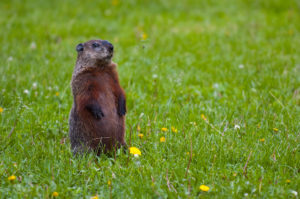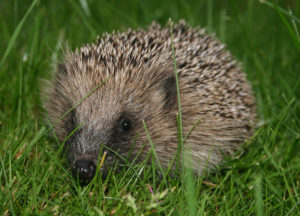Perhaps it’s a stretch to call this a conservation event—but Groundhog Day, celebrated on February 2, makes this humble rodent one of the most famous of wildlife species.

Groundhog Day has a long history, connected to both pagan and Christian traditions. In Christian tradition, February 2, the 40th day after Christmas, is Candlemas. Candlemas represents the day on which Jesus was taken to the temple to be blessed, following Judaic practice to take infant males to temple on the 40th day of their birth.
The tradition was continued in the protestant faiths as a time to take candles to the church to be blessed for the remainder of the winter. Judging how many candles needed to be taken for blessing became an early form of weather prediction. The basic idea is that the remainder of the winter will have weather the opposite of what occurs on February 2. An early English rhyme described the situation:
If Candlemas be fair and bright,
Come winter, have another flight;
If Candlemas bring clouds and rain,
Go winter, and come not again.

In Germany, the foretelling became associated with the hedgehog, a small, common and innocuous mammal of Europe, Asia and Africa that rolls into a ball when threatened. Hedgehogs—all 17 species of them—carry sharp quills on their backs that provide defense, especially when a hedgehog rolls into a ball.
When German immigrants settled in Pennsylvania, they continued the tradition of predicting the weather on February 2. However, with no hedgehogs around, they turned to a common North American rodent, the groundhog, as their weather forecaster. The original, and still most famous groundhog, is Punxsutawney Phil, who lives at Gobbler’s Knob in Punxsutawney, Pennsylvania. His first prediction, and the first officially recorded Groundhog Day, occurred there in 1887.
Since then, of course, many communities have their own versions of weather-predicting groundhogs. A notable example is Shubernacadie Sam, resident at the Shubernacadie Provincial Wildlife Park on the Canadian island of Nova Scotia. Because Nova Scotia is on Atlantic Time, Shubernacadie Sam is up and predicting an hour before Punxsutawney Phil.

Are these groundhogs reliable? Not so much. According to stormfax.com, Punxsutawney Phil has been correct 39% of the time. But it would appear that the groundhog is well aware of the effects of climate change—he’s predicted a short winter in 17 of 22 years of the new century. For the record, the folks in Punxsutawney say that Phil has always been correct, but that on occasion—61% of occasions—his handlers don’t hear him correctly and mis-report his actual pronouncements.
And just remember this: I got you, babe!
References:
Church Year. Candlemas (Presentation of the Lord). Available at: http://www.churchyear.net/candlemas.html. Accessed February 1, 2017.
History. This Day in History, February 02. Available at: http://www.history.com/this-day-in-history/first-groundhog-day. Accessed February 1, 2017.
Nova Scotia Department of Natural Resources. Shubernacadie Provincial Wildlife Park. Available at: https://wildlifepark.novascotia.ca/. Accessed February 1, 2017.
Penn Live. What is Groundhog Day? All you need to know about the holiday’s origins. Available at: http://www.pennlive.com/life/2017/02/what_is_groundhog_day_2017.html. Accessed February 1, 2017.
Stormfax Weather Almanac. Groundhog Day. Available at: http://www.stormfax.com/ghogday.htm. Accessed February 1, 2017.
